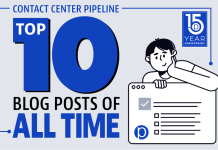
When trying to meet and improve service level agreements, reviewing agents’ performance and providing adequate training is imperative for success.
Unfortunately, making time for agent training doesn’t always seem possible. Contact centers are notorious for being extremely busy and agent time is closely monitored to ensure that customers’ calls are promptly answered.
There are a few things that you can start implementing immediately to help meet training needs while investing less time and effort and improving your outcomes.
1. Give agents access to their call recordings
Providing agents with a quick way of self-evaluation can make them immediately aware of areas that need to be improved. How? Simply give them access to their call recordings. Training that complements your standard classroom sessions can be delivered directly to their desktops.
Incorporate quick training into team meetings by listening to sample calls. Alternate between good and bad calls to highlight where the differences lie, and encourage the team to share their best practices and experiences to fill in knowledge gaps and learn from each other. Select sample calls that demonstrate successful techniques that call center agents are using, and make note of words, language and signals that received a positive response from the caller.
When coaching agents using monitored calls, be sure to allow them to listen, reflect and ask questions so they can work out for themselves which areas to improve and how.
2. Don’t randomize call selection
A recent survey conducted by Business Systems, revealed that 60% of contact centers in the U.K. select recorded calls for training at random. By doing so, they are likely to get a distorted image of the agent’s performance and potentially miss important calls. You can avoid this common mistake by using the word search options available in most call recording systems to highlight calls based on specific keywords. This will allow you to quickly find both good and bad calls and, therefore, better understand the areas in which your agents need further training. This type of insight will help you to tailor coaching sessions to the specific needs of each agent, instead of relying on chance.
If you don’t have a solution that provides word search or speech analytics to quickly identify calls, then it can be more challenging to develop a “fair” approach to monitoring each individual. Shift your focus toward the outliers—lower performers and the top performers—to capture and understand not only what isn’t working, but to identify behaviors that drive results.
3. Use scheduling and forecasting technology to block out training times when you typically experience low connect rates
Use your workforce management technology to identify when your peak times are and when you can afford to have agents away from their workstations. This will allow you to schedule training around your staffing needs and maintain the flexibility to accommodate real-time fluctuations in workload. By planning in advance and taking advantage of the expected off-peak periods, you can ensure that training does indeed happen and decrease frustration among your trainers, team leaders and supervisors.
4. Integrate customer feedback with quality monitoring
Customer service surveys are not just for understanding how a company can improve its functions, products and services. They also are extremely valuable for analyzing and assessing the quality of service provided by your agents.
You can integrate customer feedback surveys with your quality monitoring solution, which will allow you to use these as an additional method of evaluation and agent performance reporting.
5. Have a plan
When thinking about training, ask yourself:
- What are the most important skills for the team to have, and what are “nice to have”? Plan training sessions based on important skills that will affect the agent’s performance first. “Nice to have” training can be accommodated during team meetings or during one-to-one sessions as needed.
- Request that the planners schedule a minimum of “must deliver” and “essential” training for your team and provision for the resulting shrinkage.
- Use readily available data such as good and bad call recordings and customer feedback to get a clear and realistic picture of the agent’s performance.
- Look at past training sessions that resulted in positive outcomes and replicate them in this year’s plan. New employees and veterans will benefit from a review of outstanding sessions.
There you have it! You can implement these five tips immediately to get training on its way.




